My Xiong'an Tour 雄安游记
In June of 2023 I got a fairly comprehensive tour of progress on Xiong'an New Area during a 3-day visit (sorry for the late post, but shouldnt have been too many big changes since then).
First, a disclaimer: A lot of people responding to my writing on Xiong’an ask me: “so is it going to be a success, or failure,” I don’t think anyone can answer this yet. Nor is the binary choice of total success/total failure likely to be how it plays out, or the most interesting question to ask. True, a lot of hurdles remain, flooding in the summer of 2023 underscored the low-lying location which is a significant challenge for future safety of the area. Enterprises and employees in Beijing are understandably hesitant to relocate. And yet, construction continues. Since my visit in June 2023, construction has progressed on a few of the headquarters/research parks due to be completed in Summer 2024 (see bottom of post for updates). These include major offices for power company Huaneng (华能), petrochemcial giant Sinochem (中化), and research parks (a branch of the Chinese Academy of Sciences and Zhongguancun High-tech park). So when and if employees of these enterprises/organizations do move, the city may finally acquire a more vibrant character. It could take many more years before the city begins to take on a life of its own. But for now, this is a glimpse into the architectural and landscape details, the current state of construction (as of June 2023 to be precise), and other observations. Thanks for reading!
Arriving at Xiong’an station 到了雄安站!
The majority of passengers on the hourlong train from Beijing West get off at Daxing Airport, but a handful of people disembark at the final stop Xiong’an Station, which feels mostly empty on a Monday afternoon. The escalators quickly deposit you downstairs so I can’t get a proper look at the entry hall for now. But the area surrounding the station is also a construction site—China Communications Science City is in the middle of construction, a complex that will be adjacent to the HSR station and is supposed to house innovative industries.
However, right now the recently completed Xiong’an Station is a 30 min drive away from the main area of Xiongan, where my hotel is. In the future, you will be able to transfer from HSR to the city’s underground subway line, which will take you directly into the downtown Qidong District, where another city station is currently being built.
The reason for building the HSR far from the main urban center? Most HSR stations in China have been built outside of existing urban centers due to ease of land acquisition and because it allows cities to create massive new urban areas alongside the new stations, essentially a fiscal revenue cash cow that can also help contribute to funding the rail project. The location of Xiong’an Station embodies a similar logic—the station allows for another area to be developed for commercial use. It also allows for a separate N-S rail line, and an E-W intercity rail line to run from Tianjin into central Xiong’an, passing through the Xiong’an Railway Station (see map) and eventually to the city center station (城际站)which is currently under construction in the business district of the Qibu District CBD area. Many of the HQ of prominent companies will be located in this area near the city center station.



Check-in, The Commercial Service Center 会展中心与商务服务中心




After the 30 minute DiDi ride from Xiong’an Station, I arrive in Rongdong District, the first phase of Xiong’an to open. We pass through blocks of housing, not a whole lot of residents around but there are traces of life: motorcycles and a few people walking around. It isn’t entirely a ghost city but definitely not fully inhabited.
The Xiong’an Convention Center Hotel occupies part of the Citizen Service Center, which is kind of a all-in-one formal complex housing a convention center, hotel, office buildings with spots for the 4 banks, and offices for some other financial companies operating in Xiong’an. I check into my hotel. The front desk staff are a bit surprised to see a foreigner here, but they are very polite, and I am told I have been upgraded to a “lake view” room. The lake? The pond in the middle of the Citizen Service Center Project.
After checking in, hearing the dramatic welcome music in my room, I go down and ask the concierge about things to do. I talk to a young guy who tells me he is from Zhajiangkou (a city in northern Hebei province), “actually there isn’t much worth seeing around here” he tells me. Clearly not part of the official script! But he’s very nice and gives me the card for a local taxi driver who can pick me up and drive me around the following day.
Outside, its almost dusk as I wander around the mostly empty Commercial Service Center. A grass stretch leading to the plaza from the south is lined with heavy bronze plaster reliefs showing various scenes from the area’s geography and history such as the Baiyangdian wetlands. The whole area feels a bit empty. The massive sunken pool in the middle of a large plaza serves as the design focal point of this district, a sort of distillation of the solemn, conservative, restrained “high quality” look that is infused into the design. No more weird architecture here, that’s for sure. Almost all buildings are clad in some sort of exterior material other than glass—metal or stone. Apparently Xi Jinping himself disliked “glass curtain facades” and haphazardly erected skyscrapers, preferring natural materials and subdued heights.






Building Facade Textures: No Glass Curtain Facades (mostly)

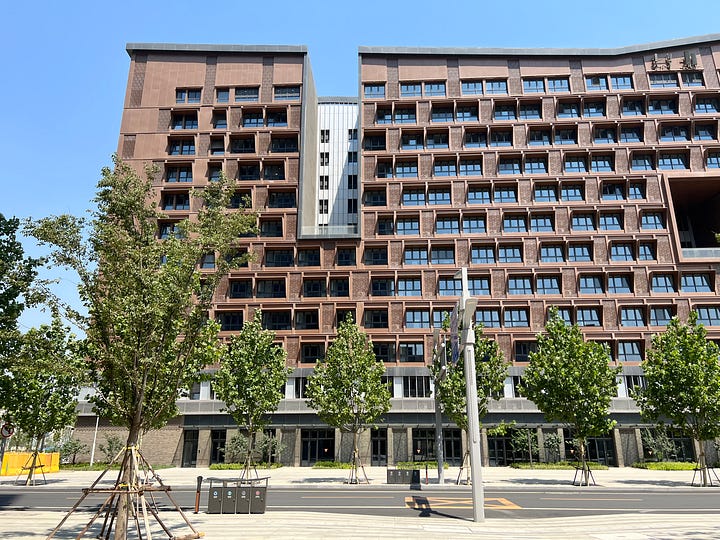


Xiong’an Impression: Urban Exhibition
雄安印象
While the main urban exhibition hall located just south of my hotel is closed to outside visitors, and mostly used for official government visits, the Xiong’an Impression 雄安印象 exhibit hosted at Power China’s Science City complex provides a pretty well-curated exhibit on the city’s design and planning, with a small model, and videos on aspects of the city’s development such as its “smart city” digital platforms. There was a pleasant air-conditioned cafe with a range of books and merch including some on Xiong’an itself, and this was one of the spots where residents seemed to be enjoying themselves and it felt like a real city.






Power China Science City 电建智慧城
Power China is the english name of 中国电建, or Power Construction Corporation of China, a massive SOE comprising Sinohydro and other construction companies, many of which have been active building infrastructure across Asia and Africa as part of the Belt and Road Initiative. The SOE has obtained a plot of land within the Rongdong District for mixed-use development. The Wyndham Hotel is located in this part of the city, but I did not stay there.

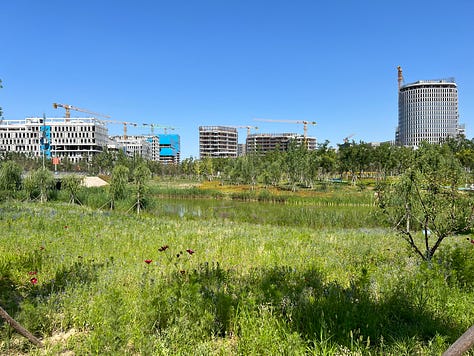


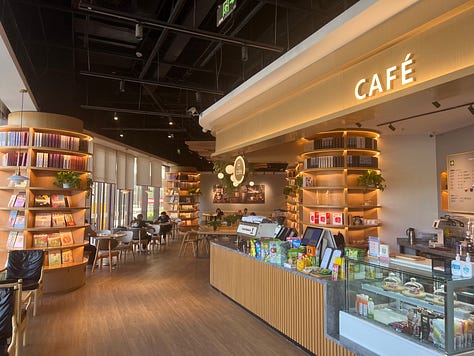

Yuerong Park 悦榕公园
As the sun goes down, I think its finally cool enough to wander around Yuerong Park, the signature park in Rongdong District, that abuts the Commercial Service Center. The park is designed around a lake, featuring a towering pagoda atop a hill that is the focal point. I walk through the park, mostly deserted, as the sun starts to set. Vaguely traditional Chinese music is piping in from a hidden speaker somewhere, and a recording tells all guests to please be aware of park regulations, children must be accompanied by an adult, and so forth..There are a few people wandering the park, and I walk north, passing over the lake, with a Tang-style pavillion and viewing deck with a nice view of the pagoda across the way. Then I heads to the pagoda, which sits atop a small hill and plinth. From here, I take in a panorama of the park and Rongdong District beyond. It’s not bad, actually. High quality development indeed!
As I walk towards the north exit, I come across a slightly more hokey design element, a large rockery with a waterfall. It’s a bit of Disneyland Splash Mountain mixed with Chinese garden.



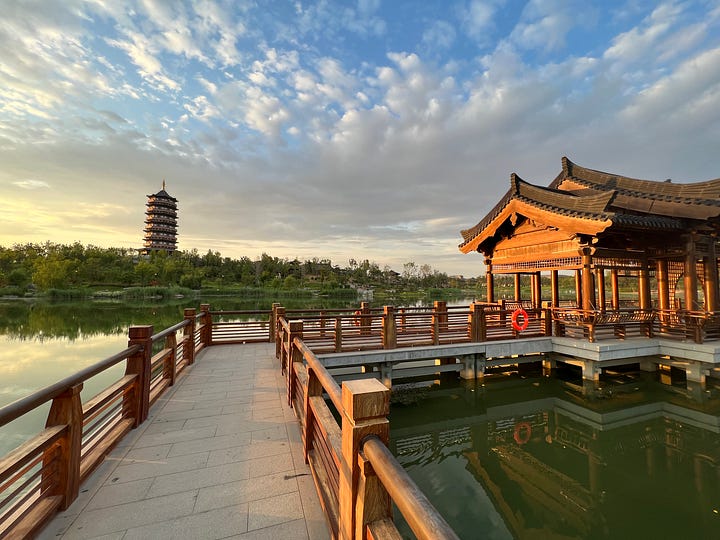
Qidong District 启动区
The second day I was to hire a driver. He hasn’t himself visited the Qidong District, the main part of the city now under construction, but he takes me along newly completed roads that crisscross the area. Some of the main roads are evocatively named for nature: i.e. “nine rivers” that flow into Baiyangdian wetlands like 九河大街, another is named for the ancient kingdoms of Yan and Zhao that occupied this part of China 燕赵大街. There are strict guidelines on diming or place names in Xiong’an—Western-sounding names that proliferated in the mid 2010s in luxury home developments like “Orange County” or “Vancouver Forest” are gone, replaced by pastoral or traditional names. One residential community in Rongdong is even named 富强园, “rich and powerful garden”, alluding to the oft-stated desire of Chinese leaders to make the country rich and powerful again. Another is called Huawang Cheng 华望城, or “city of the Chinese dream”, indirectly referencing the popular slogan 中国梦popularized during the early years of Xi’s tenure.



There isn’t a whole lot of traffic right now. There are construction sites scattered across the flat plain, but it doesn’t seem to be at peak construction activity right now. The roads are lined with camps of some of the major construction companies like China Rail Construction 中建 and China Communications Construction 中交建. Temporary white stacked containers serve as onsite worker’s housing for some of the sites. According to my driver “most of the workers live in these dormitories, but there are also some living in the county town or elsewhere,” he tells me.
When I ask him if locals have benefited from Xiong’an so far, he says quite bluntly “to be honest from my perspective, Xiong’an doesn’t have much to do with us. The jobs available for construction are just the most low-end jobs. Most of the workers are from elsewhere in China, more from the south but everywhere. For professional jobs, most locals don’t have the proper qualifications. They may require a masters or even PhD degree. He also explained how since the city was declared in 2017, the government ordered a shutdown of polluting factories to help improve the ecological quality of the Baiyangdian wetlands, a key goal of the area’s “green development”. But according to my driver, the local government took this goal much more zealously than was necessary, shutting down even small non-polluting factories just to comply with the central policy. “it’s true,” he told me, “the environment is better. It’s just, there’s no money to be earned. Maybe in a few years when the central enterprises relocate there will be more benefits, but for now it’s not great.”
Many of the buildings I saw under construction were. research institutes for the 3 major telecom companies (China Telecom, China Mobile, China Unicom), each of which is building a research office in the “mobile internet research park” area of Qidong. There is also the China Satellite Communications 中国星网 HQ, a pretty large low-rise star-shaped office complex that seemed to be nearing completion.
Streets are lined with various traffic signal poles, mounted with various types of cameras and sensors. According to a consultant who worked on the digital twin of the city, there are various types of sensor platforms in Xiong’an, all of which are part of the effort to turn the city into a smart city, complete with real-time information from IoT sensors and traffic cameras almost everywhere in the city.











Three Cities 三座城
Xiong’an has been described as “three cities”: the city on the ground, the city underground, and the city in the cloud. This refers to underground utility corridors, or 地下管廊 that will carry utility mains and logistics deliveries (if goes to plan). The corridors are wide and deep, allowing additions as capacity increased and allowing easy maintenance without requiring cutting and covering streets to get to utility lines as is the case in older cities.





Smart City 智慧城市
Xiong’an has been promoted as a “smart city”. While many cities around the world have aspired to this vague but aspirational term, Xiong’an has a few aspects that are unique. The city is constructing a digital twin (数字孪生城市) of the entire city, using a new digital platform that is built on GIS (geographic information systems) and BIM (building information management) developed by a division of Xiong’an Group, with partnership of China Telecom, Alibaba, and consultants from China Academy of Urban Planning and Design. According to a consultant who worked on the project, while there are other similar efforts to build 3D digital twins in China, Xiong’an is the most comprehensive one being built “From the ground up”, building a digital replica block by block as the city itself is built. Whereas Alibaba and Huawei have been promoting smart city platforms in China and elsewhere, in Xiong’an the state telecoms are highly involved—China Telecom in particular holds a 49% stake in Xiong’an Digital City Company, which is the company (owned by the LGFV Xiong’an Group) developing the city’s digital systems.

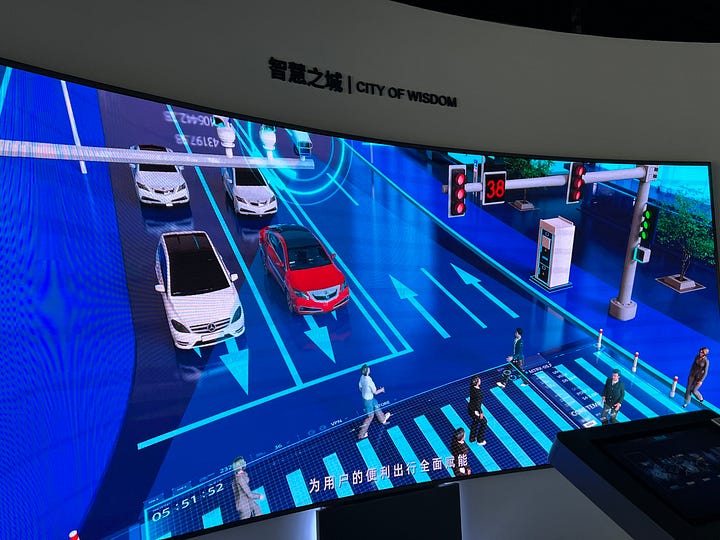



A Red City 红色城市
Throughout Xiong’an are numerous posters and propaganda slogans, which remind one of the political nature of the city and its direct connection to Xi Jinping. Slogans like 千年大计国家大事 “thousand year plan of national significance” are frequent. Another displays Xi’s slogan about the value of environmental protection 绿水青山就是金山银山 “clear waters and green mountains are mountains of gold and silver,” and a particularly colorful one featuring pagodas, geese and a train read 解放思想奋发进取 “liberate the mind, forge ahead.”




Baiyangdian Wetlands 白洋淀
The final stop of my Xiong’an tour was the Baiyangdian wetlands. After all, the wetlands are a big symbolic (and material) element in the decision to build Xiong’an where is is. When the location for the city was chosen between 2015 and 2017, planner Xu Kuangdi (former mayor of Shanghai and Chair of the Jing-Jin-Ji Coordinated Development Commission) remarked that the wetlands offered a chance to build “an ecological and liveable city that blends water and city, blue and green reflecting each other.” The land directly north of the wetlands, where Qidong District was to be built, was sparsely populated, which would make relocation and demolition costs lower. But of course the reason why this strip of land was rather sparsely populated was because it was in a low-lying flood plain. In 1968, devastating floods had inundated the very area where Xiong’an was being built. The area is “around 8 or 9 m below the long-term floodline”1. Thus, as Yin Zhi, one of the chief planners involved in the project remarked, “to make such a large area safe for development, there needs to be significant engineering work to make the area safe.” There has also been significant investment to clean the water of the wetlands, which has largely resulted in the closure of nearby light manufacturing plants since the city’s founding in 2017. This has indeed improved the water quality, but also forced many locals out of work.
The wetlands are known as the “pearl of North China” or 华北明珠, and are one of the largest freshwater bodies of water in Northern China. They play and important role in draining the north China basin. They are fed by 9 rivers, and eventually drain Eastward into the Bohai Sea just south of Tianjin. The wetlands are home to villagers, some of whom live on floating villages in the marshes themselves. During the war of anti-Japanese resistance, some of these villagers ambushed the invading Japanese. The legend of these “marsh dwellers” thus gives yet another compelling symbolic element to the selection of Baiyangdian as a core focal point for Xiong’an.
The descendants of these same villagers were some of the people operating the boats. After passing the newly constructed ferry terminal, which was constructed by a Beijing-based company to formalize tourism in the wetland, I was approached by an old man and asked if I wanted to take a tour from his village. He told me since the new wharf’s construction the local villagers could only operate their smaller boats from a wharf located next to their village. Well this seemed like a more authentic experience anyways, so with the sun was setting I had to seize the chance to see the wetlands so I hopped on his small pedicab. I was taken to a nearby village, where I waited for a few minutes, chatting with some of the aunties looking over a smaller wharf. Eventually a boat arrived, helmed by a rather hefty and jovial fellow. And off we went, cruising around the lake during the sunset. We picked some lotus leaves (one of my fellow passengers, who were visiting from Shanxi, used them as a hat, why not). We zipped in and out of the open areas of the marsh and through tall reeds. We didn’t have time to stop at the official museums located inside, such as a lotus garden and a museum of anti-Japanese resistance. But I considered it to be a pretty good tour of the pearl of North China. And I even got to take some lotus leaves home to make tea…







Construction Updates (Nov 2023)
Since I visited (about 6 months ago), there have been a few updates in construction. The HQ of Huaneng is topping out, offices for China Mobile and the Xiong’an Innovation Center ( a branch of the Chinese Academy of Sciences) also appear to be nearing completion, and the stadium seems to be nearing completion as well. The pagoda-like tower hq of Sinochem is also rising (Pictures from Xinhua, 11. 2023)












Just booked a weekend trip to Xiong'An. Will see how much has changed since this!